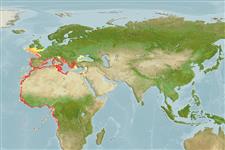Common names from other countries
Environment: milieu / climate zone / depth range / distribution range
Écologie
marin démersal; profondeur 50 - 848 m (Ref. 56504), usually ? - 150 m (Ref. 10780). Deep-water; 52°N - 15°S, 18°W - 36°E
Eastern Atlantic: British Isles and English Channel to Angola, including the Mediterranean.
Length at first maturity / Taille / Poids / Âge
Maturity: Lm ?, range 22 - ? cm
Max length : 40.0 cm TL mâle / non sexé; (Ref. 3397); common length : 18.0 cm TL mâle / non sexé; (Ref. 3397)
Depth range from 50-600 m (Ref. 10780) and from 288-848 m in the eastern Ionian Sea (Ref. 56504). Gregarious. Occurs on muddy or rocky bottoms of the shelf. Digs the mud with its rostrum, searching for prey; stands and walks on the bottom with its free pectoral rays. After a pelagic existence, the juveniles live in coastal waters before migrating to deeper waters (Ref. 6556). Minimum depth range taken from Ref. 27000.
Life cycle and mating behavior
Maturities | Reproduction | Spawnings | Egg(s) | Fecundities | Larves
Wheeler, A., 1992. A list of the common and scientific names of fishes of the British Isles. J. Fish Biol. 41(suppl.A):1-37. (Ref. 5204)
Statut dans la liste rouge de l'IUCN (Ref. 130435)
CITES (Ref. 128078)
Not Evaluated
Menace pour l'homme
Harmless
Utilisations par l'homme
Pêcheries: pêcheries vivrières
Outils
Articles particuliers
Télécharger en XML
Sources Internet
Estimates based on models
Preferred temperature (Ref.
115969): 8 - 17.4, mean 13.8 (based on 488 cells).
Phylogenetic diversity index (Ref.
82804): PD
50 = 0.5000 [Uniqueness, from 0.5 = low to 2.0 = high].
Bayesian length-weight: a=0.00427 (0.00338 - 0.00539), b=3.05 (2.99 - 3.11), in cm Total Length, based on LWR estimates for this species (Ref.
93245).
Niveau trophique (Ref.
69278): 3.6 ±0.3 se; based on size and trophs of closest relatives
Résilience (Ref.
120179): Milieu, temps minimum de doublement de population : 1,4 à 4,4 années (Preliminary K or Fecundity.).
Fishing Vulnerability (Ref.
59153): Moderate vulnerability (38 of 100).
